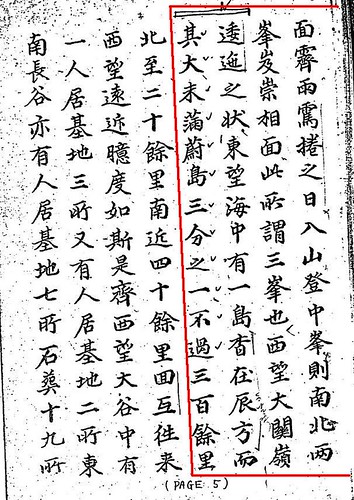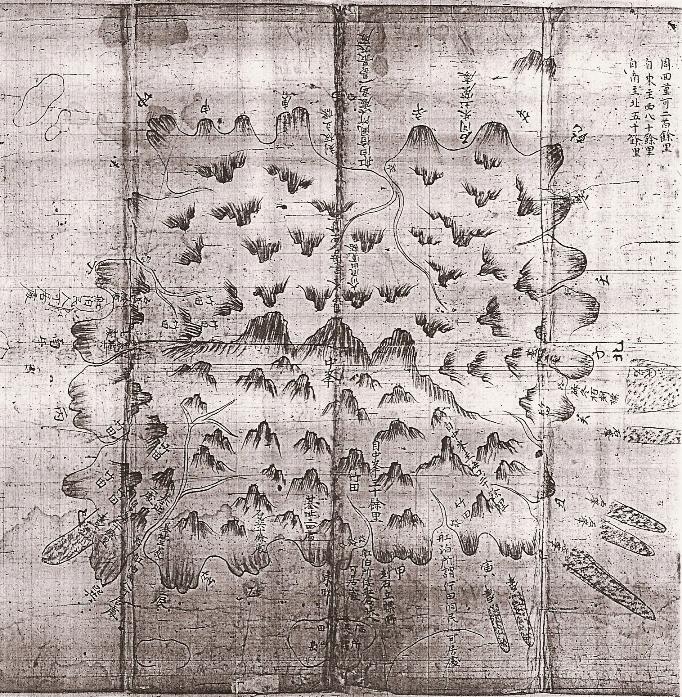

Japan and Korea are no longer disputing each other's claim to Ulleungdo since Japan conceded Ulleungdo to Korea in the 1690s, but the two countries are disputing over Liancourt Rocks, which are a small group of rock islets about ninety-two kilometers southeast of Korea's Ulleungdo and about 160 kilometers northwest of Japan's Oki Islands. Koreans call the rocks "Dokdo," and Japanese call them Takeshima (竹島), which was also the former Japanese name for Ulleungdo. The Jang Han-sang expedition to Ulleungdo in 1694 is significant in the Dokdo/Takeshima debate for a few reasons. One reason is that it seems to be the only time that Liancourt Rocks (Dokdo/Takeshima) was mentioned in Korean records. In the record, no name was given for Liancourt Rocks, but Jang Han-sang said that he saw, from a peak on Ulleungdo, an island in the distance, about 300 ri (120 kilometers) southeast of Ulleungdo. We know that he did not travel to Liancourt Rocks because he estimated the size of the island to be about one third the size of Ulleungdo; however, Ulleungdo is actually about 391 times bigger than Liancourt Rocks.
Another reason the Jang Han-sang expedition to Ulleungdo is significant in the Dokdo/Takeshima debate is that Jang Han-sang said that Ulleungdo was "the so-called Sambong" (此所謂 三峯), which was a reference to Sambongdo (三峯島). "Sambongdo" means "Island of Three Peaks." Koreans say that Sambongdo was one of the old names for "Dokdo" (Liancourt Rocks), but Jang Han-sang's report and other references to Sambongdo in Korean documents show that Sambongdo was just another name for Ulleungdo.
A third reason that the Jang Han-sang expedition is significant is that he reported seeing a small island about five ri (2 kilometers) off the east coast of Ulleungdo. He said that the island had groves of haejang bamboo (海長竹) on one side. The island he was talking about was almost certainly Ulleungdo's neighboring island of Jukdo, which is about 2.2 kilometers off Ulleungdo's east shore. The fact that he said the island had groves of haejang bamboo (海長竹 or 海藏竹) on it is also significant because haejang bamboo is a particular type of bamboo that can grow seven meters tall. On a 1711 map of Ulleungdo, made by Ulleungdo Inspector Bak Chang-seok (朴昌錫), there is a small island off the east coast of Ulleungdo labeled "Groves of Haejang Bamboo, the so-called Usando" (海長竹田, 所謂于山島). Koreans claim that Usando was the old Korean name for "Dokdo" (Liancourt Rocks), but Jang's 1711 maps shows that Usando could not have been Dokdo because Dokdo does not have the soil to grow "groves of haejang bamboo." Besides, Dokdo is ninety-two kilometers southeast of Ulleungdo, but Jang's map shows Usando just offshore of Ulleungdo.
Considered together, Jang Han-sang's 1694 expedition report and Bak Chang-seok's 1711 map make it quite clear that "Usando" was not Liancourt Rocks, but was, instead, an old name for Ulleungdo's neighboring island of Jukdo (竹島), which, by the way, does have bamboo growing on it.
Here is the relevant portion of Jang Han-sang's 1694 report (蔚陵島事蹟) and scans of Bak Chang-seok's 1711 map of Ulleungdo. Notice that in the center of the island on Bak's map, he drew three peaks (三峯) in a way that they stood out from the surrounding peaks. This is more evidence that Sambongdo (三峯島 - "Island of Three Peaks") was just another name for Ulleungdo.
Excerpt form the 1694 "Ulleungdo Sajeok" (蔚陵島事蹟)About five ri to the east is one small island. It is not very big or very high, and it has a grove of haejang bamboo (海長竹) growing thickly on one side. On a day the rain clouds cleared and the fog settled, we went into the mountains and climbed the central peak. Two tall mountains to the north and south were facing us. This was the so-called Sambong (三峯 - "Three Peaks"). The winding shape of Daegwanryeon (大關嶺 - mountain range on the east coast of the Korean peninsula) was visible to the west. Looking toward the east, there was one island far off to the southeast. The size was only about one-third of Ulleungdo. It was only about 300 ri [120 kilometers] away.
동쪽으로 5리 (2킬로) 쯤에 한 작은 섬이 있는데, 고대(高大)하지 않으며 해장죽 (海長竹)이 한쪽면에 무더기로 자라고 있다. 비 개고 안개 가라앉는 날 산으로 들어가 중봉에 오르면 남북 양봉(兩峯)이 높다랗게 마주보고 있는데 이를 삼봉(三峯)이라고 한다. 서쪽을 바라보면 대관령의 구불구불한 모습이 보이고 동쪽을 바라보면 바다 가운데 한 섬이 보이는데 아득히 진방(辰方)에 위치하며 그 크기는 울도의 3분의 1 미만이고 (거리는) 삼백여 리에 불과하다.
東方五里許 有一小島 不甚高大 海長竹叢生於一面 霽雨?捲之日 入山登中峯 則南北兩峯 岌崇相面 此所謂三峯也 西望大關嶺逶迤之狀 東望海中有一島 杳在辰方 而其大滿蔚島三分之一 不過三百餘里.
1711 Korean map of Ulleungdo (鬱陵島圖形) by Bak Chang-seok (朴昌錫)

Gerry,
ReplyDeleteI think this is the only one Korean document about Liancourt rocks. They saw the rocks but had not information about them - they even didn't know the island consisted of two rocks.
They didn't name the island. They were not interested in the rocks that located far away or simply thought they were other country's island.
Actually, since I am a Korean and I studied Korean history, Jang han sang drew Dok do clearly enough. Also, isn't it obvious that he would have just boom named the unknown island? He had no authority back then!
ReplyDeletegirl,
ReplyDeleteThe document only mentions that the author saw an island far to the southeast. It may have been the first Korean record about Liancourt rocks. But the author didn't go to the island, he didn't know the exact shape of the island, exact distance from Ulleungdo.
And Japanese fishermen already went to Liancourt rocks before going to Ulleungdo at this point. But there is no record that Korean people went to the island.
Under the international law, you can't claim for a land even if you saw it from a distance. You have to occupy it and effectively control it. But there is no record that Korean people occupy it or control it.
Well, well well. Pacifist is going to lecture us about international law and colonial land acquisitions.
ReplyDeleteJapan's annexation of Dokdo in 1905 is questionable on so many levels there isn't enough bandwith on the blog to list them all.
Well,well,well, Steve is still in doubt as to Japan's annexation of Dokdo in 1905 after so many explanations;there isn't enough bandwith on the blog to list them all.
ReplyDeletePonta, do you always refer to yourself in the third person when you post on Occidentalism or did you did you have trouble logging in to your other sockpuppet identity on Occidentalism? See this link.
ReplyDelete-
Ponta Sockpuppet
-
It looks like others on this blog are onto your game as well.
-
Ponta 2
dokdo-takeshima.com
ReplyDeleteSteve, oh, Steve.
Ponta on occidentatism is Ponta, me.
Who wrote the comment other than me, Ponta.
Who the hell writes the comment like that other than me? Steve?
And you call it sockpuppet? Oh, Steve, what's with you?
And Ponta2 ?
Oh Steve, why are you Steve? Steve?
You also think amPONTAn is Ponta?
Thank you.
But Bill is an native American, I am a native Japanese. It was stupid TPR which mistook me for Ampontan. And Bill, Ampontan posted it as an stupid example, you know.
I live in Tokyo. Bill lives in Kyusyu where it will at least take a half day from Tokyo. I went to Tsukiji in Tokyo to ask Tsukiji owner to pull down "Japanese only" post. You
know that?
http://www.occidentalism.org/?p=829
Who the hell will go to Tokyo from Kyusyuu to do that?
Oh, Steve, what happened with you?
went ga ga?
But thanks I had a good laugh.
Yes Ponta you did say the quote I linked to.
ReplyDeleteThe fact is you thought you were logged into your other sockpuppet. That is why you referred to yourself in the third person. Either that or you have a mulitple personality disorder. (Both possible I guess)
You could tell by the way you double posted in one minute, you were having trouble logging in. Then you quoted as if "Ponta" was another person thus the 3rd person entry.
Ponta Busted
O.K. I can play your game. Toadface says you are a fake.
Steeeeve, Oh, Steeeeve.
ReplyDeleteNot everyone is playing the game like
you.You are just projecting what you are doing.
Nobody writes English as badly as me.
See, the only person who respond to you is Ponta, your real friend.
Anyone please translate the red-line part of 鬱陵島事蹟 below
ReplyDelete其中冬紫檀最多松木直木捺木檬等木●終無一株而羽則鳥鴎毛則猫睨而巳此外別無飛走之●●無人居又無木賽可食而水族即只有鮫魚而獲沿邊碓処戒十戒百成●穴居大如駒特小如犬承間有生腹付諸尾石責者躯小味薄四方裏邊破船板木●●漂着者処処有之而或鉄釘或木釘或腐傷者而審其稍木之制
以前に判読したテキストですが、此方にも貼っておきます。
ReplyDelete西渓雑録と蔚陵島事績の両者で本文が重なる部分
甲戌九月初二日、営将張漢相、馳報備局。江原道三陟鎮右営将、為馳報事、欝陵島捜討事。去九月十九日、巳時量、自三陟府南面、荘五里津頭、待風所、発船。緑由曽己馳報、為有在果。僉使、與別遣譯官・安慎徽、領率員役各人、及沙格并一百五十名、騎ト舡各一隻。汲水舡四隻、良中、従其大小分載。同日巳時量、因西風開洋。是如乎。戌時量、到大洋中、波涛険巇之勢、五里許二處。是乎所。必是水臽、而諸船為波浪、所觸一時渙散、莫適所向。是如乎。
同月二十日、子時量、漸入深洋、黒雲自北蔽天、而電光閃爍、影徹波心。狂風猝起、驟雨随至、怒涛翻空、[雲海相盪]、[所乗]船隻、若浮若没、危険网状。舡中之人、莫[不失措]、
舉皆昏倒之際、騎舡柂木、又従而折破尤無[制船]之望而。
強以櫓木、直挿於 船尾及左右、[借以為力]、是乎乃。覆沒之患、迫在斯須。是如乎。風[雨漸息]、天又向曙、而島在北方、水勢東注。故、船中之人、[因此]甦醒、盡力櫓役、輾轉向島。巳時量、艱到島之南岸、繋纜石角、蹔時下陸。炊飯之際、汲水船四隻、自南洋稍々来到。而卜舡叚不知所向。是如乎。
酉時量又自南洋西至、各舡倶得免恙。南岸無可舡泊處、乙仍乎。
同日初昏、回泊于東南間涧口内、止宿。後、自二十一日、至十月初三日、留住之間、恒雨少日、九月二十八九日、雨雪交下。中峯腰上、積雪尺許。是齊。
島之四方、乗船環審、則、懸崖撑空、層巌壁立。或有空缺處、澗水成流、似是大旱不渇。而、其間細流乾渓、不可殫記。是齊。盖其周回、二日方窮、則、其間道里、不過百五六十里之地。是乎弥。南邊海濱、有篁竹田三處、東西北三方、亦有篁竹田十一處、是遣。東方五里許、有一小島。不甚高大、而海長竹、叢生於一面。是齊。雨霽雲捲之日、入山登中峯。則南北兩峯、岌嶪相向、此所謂三峯也。西望大関嶺、逶迤之狀。東望海中、有一島、杳在辰方。而其大、未満欝島三分之一。遠不過三百餘里。而、南北両方、即杳茫。無際水天一色。是齊。自中峯、西至海濱三十餘里、東至二十餘里、南近四十里、北至三十餘里。互回往来。四望遠近、臆度[如斯]是齊。西邊大谷間、有人居基址三処。又、有[人居基地、二]所北邊長谷、又有人居基址二所。東南長[谷、有人]居基址二所、西南間大谷、有基址七所、石葬[十九所]是齊。
舡泊處、則、東南間澗口、厪容四五隻[之處]地。而、東南風、則亦非可藏處。是遣。此處[有三]釜二鼎、而二釜一鼎、則破傷。釜鼎軆樣、非我國之制也。鼎、則、無足無盖、其大可炊二斗米。釜、則、廣径尺許、深可二尺、容盛水五六桶。是齊。西邊大谷、溪澗成川、沿邊開豁。此處、為最而所。泊舡處 可避東南北風。而西風則難避。元非 船泊之所。而又有一鼎、可容斗米之炊。而亦是彼物。是乎弥。北邊浦岸上、有轆轤。亦非我人所造。是齊。島中、崗巒重疊。而、山腰以上、則皆是石角、腰下則土山。而、山勢絶險、洞壑深邃。連抱樹木參天而蔽日者、不知幾其許。叱分不喩、積年空棄之地、人迹不到。故、藤葛盤結、[朽草木添阜]、有難排躋、卒非人力之所可通逕。小小澗谷、不暇窮探。是齊。
所謂樹木、盡是、冬栢、紫檀側栢、黄檗、金椢木、嚴木、槐木、椵木、桑、楡、楮、椒、楓、檜樹、栢之類。而、其中、冬栢紫檀、最多。是乎弥。松木、真木、榛、橡等、木叚、終無一株。而、羽則烏鷗。毛則柚鼠而已。此外、他無飛走之屬。是乎。
所既無人居、又無木宲可食。而然是乎、喩亦甚可怪。是齊。水族、則只有可支魚。而沿邊石堆處、或十、或百、成群穴居、大如駒犢、小如犬豕。是乎弥。間有生鰒、之附諸岩磧者、軆小而味薄。是齊。四方浦邊、破船板木、片片漂着者、處處有之。而、或[着鐵釘]、或着木釘、或有腐傷者、[而審其稍木之制則彼我無別已為裂破] 而、東南崖[岸漂散]最多。是齊。
竹田中、東南麓三處、最大。[而毎處可]、落皮牟三十餘石。是乎弥。且兩田、斫竹尤[多、其傍斫]置者、無慮數千竿。而、或有陳枯者、或有[未乾者]。是齊。自東南間渓谷中、向南至竹田、有十五里許、小路。[處]此必取竹[者]、徃來之逕。是齊。大抵環一島、皆石山。四面壁立。而少有罅缺處、則兩峡成澗流水潺湲而已。只一西山方麓、開成澗門、大川流出、而沙礫堆積、不能成浦、船泊甚艱。是乎弥。中有峯巒嵯峨、澗壑、回互雖。無寬豁處、猶可開墾、是乎弥。至於殘山平夷處、或有人居基址、石葬而墓木連抱、廢垣石堆而己。即不知、何代所
テキスト後半
ReplyDelete張漢相が状況を備辺司に報告した内容
(蔚陵島事績にあり、西渓雑録にない文)
大槩島在、三千里、海洋之中、船隻不得、任意徃來、則、雖有彼國橫占之舉、除防無策、欲設堡鉄、則、人民無止接之策、所謂、開垦處樹木陰翳、藤葛成藪、九月積雪、寒氣倍冬夜半風殘之時、依然如児啼女哭之聲、喧嘩碎長之聲、錚々耳邉、漸近、船頭擬其、魍魎海毒之舉、妖或慮率備犯之患、吹囉放砲撀、鼓作聲、則、瞬息不聞。環島之時、至一處日暮、繋船巖下、炊飯次船、則、沙磧履磨中有涇之狀、與、安慎徽、同步行三里許、則、自中峯逶迤一脉山麓、都是層巖高壁、而至遙開豁由此路望見、則、連及山腰疊石成穴與、慎徽相議曰、此穴不無害人毒物移船於、他處矣到、三更後、天雨猝下、風浪大作、震雷電光、動山掀海、俄以雨止、烟霞满島、遙聞巖穴中眾人之聲立扵、船頭望見、則、燈燭煒煌明日食後、欲知其夜、聞異狀更泊其處、使軍官、朴忠貞及砲手二十餘名、探知次入送巖穴、則、久而不出疑其陷坎、使人呼出、則、忠貞先、出曰穴內三十餘步、豁然開敝、四層築砌、累石皆錬磨玉色有文彩也、十餘間瓦家、甚極奢麗、丹青及戸牖之制、非泛然我國搆屋之規則、模樣大異無他見物而近入簷下、則、如硫黃腐肉之嚊滿鼻敝口不能遠行亦分明說道是去乙僉使多率船卒六十餘名親自入見果如忠貞所告屋上藤葛盤結之中階砌庭城之内蕭灑無一累之塵非人所居處、則、強入非関、兺不喩、心迷宜不忍近入簷下、回船之日、自中峯、霞氣漸廣及於海中大如朿山不知何物浮沈數度超出半空向入山中風雨大作非電震之聲、而、動如崩山之狀、此其他島有異者也。所謂、竹田處々有之、而、上項四千處叚小處二十餘石、落只之地大處三十餘石、落只而皆可引水作畓處是齊。樹木中紫檀可作棺板皆在於山腰落巖之間古昔人民居基地宛然未泯則其為空棄不過百餘年之前、溪有洞口若慮備寇之策則一夫當百夫之地彼船雖欲久為結船而風浪若開則船必不保之勢登島山峯審望彼國之域則杳茫無眼杓之島其遠近未知幾許而地形似在於彼我間鼎釜取竹之路彼人所為緑由馳報狀
壬寅春外後裔永陽申光璞書
小嶋さん
ReplyDeleteいつもありがとうございます。
なかなか時間が取れずに、先ほど気が付きました。
メモ代わりでも構いませんので、どんどん書き込んでおいてください。
よろしくお願いいたします。
Kaneganeseさま
ReplyDeleteこちらこそいつも有り難う御座います。
皆様
上記テキストですが、
「曽已馳報」と訂正すべきところ「曽己馳報」のままでした。
また
「㹨鼠」と訂正すべきところが、「柚鼠」のままでした。訂正願います。
柚(ゆず)ではなく、㹨(Unicode3E68) イタチです。
蔚陵島事蹟の善本というべき「西渓雑録」では、最初の方に「鼠大如猫」という明らかに猫を示す漢字の書き方があるのですが、それに対して、蔚陵島事蹟と内容の重なる西渓雑録の後半のこの部分の漢字は、ケモノ偏で、旁は、苗ではなく、「由」という字で書かれています。
したがって、鼬(いたち)を示す別字の㹨(いたち)と判読されます。
張漢相の報告にある鬱陵島の動植物を列挙している、「輿地圖」 (1736 - 1767)でも、獣偏に、由の「㹨」になっています。
http://blog.naver.com/storyphoto/viewer.html?src=http%3A%2F%2Fblogfiles4.naver.net%2Fdata32%2F2008%2F7%2F19%2F115%2F0014_1736_cms1530.jpg
「西渓雑録」より「蔚陵島事蹟」の方が誤字が多く、
蔚陵島事蹟ではこの部分が、「貓兒」=「猫児」となっています。
この「㹨」という字は鼬よりも、誤読されやすい所為か
後の海東地圖でも、猫にされています。
http://blog.naver.com/storyphoto/viewer.html?src=http%3A%2F%2Fblogfiles9.naver.net%2Fdata32%2F2008%2F7%2F19%2F232%2F0018_1700m_cms1530.jpg